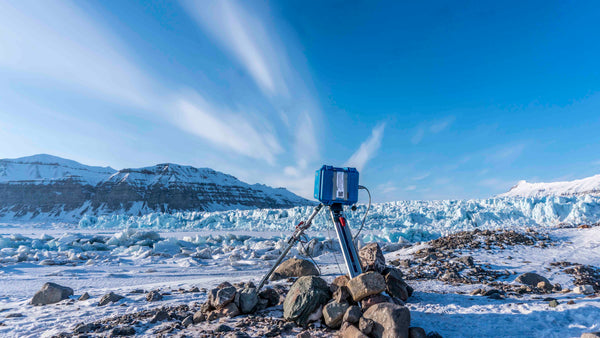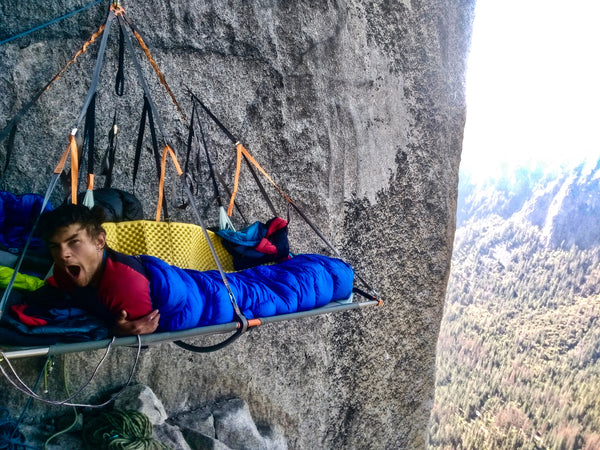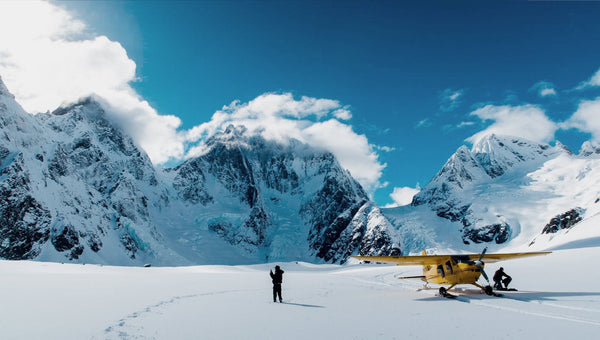Nutrition at high altitude
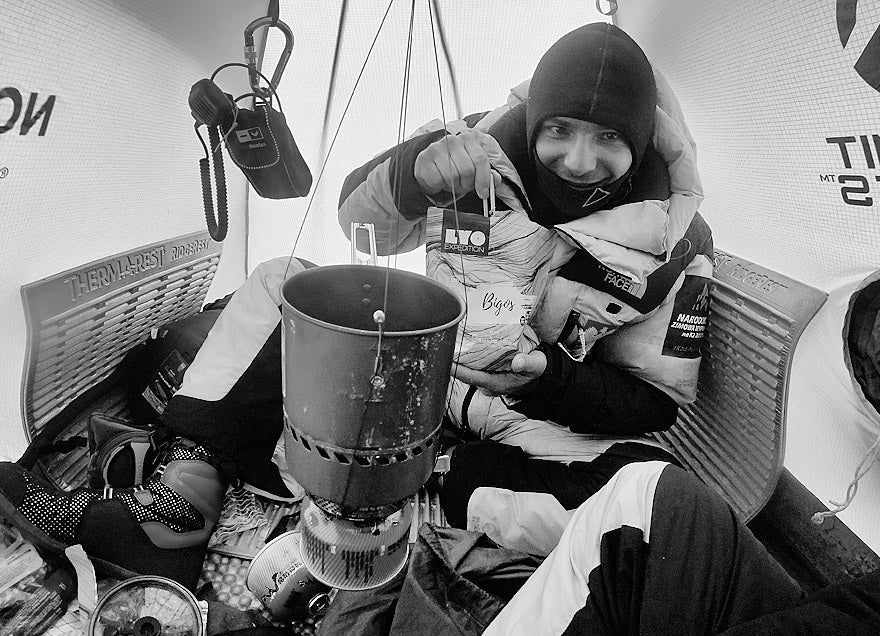
Artur Malek, Polish K2 winter expedition
Travelling at high altitudes for both sports and recreational purposes puts out a challenge to the human body in terms of physiological, physical and mental aspects. Choosing right equipment, being in good condition and practicing one's technical abilities are vital elements before travelling to mountains. Regardless of whether we want to achieve a high level of sport skills, reach our goal in comfort or even at our peak, it is worth taking care of our body which means proper nutrition. At the end of the day, even the best car will not run without proper fuel. Nutrition at high altitudes is a vast topic. Both in terms of recommendations and individual preferences. While book recommendations are one thing, there is also a practical element in the mountains that does not always allow them to be put into practice all the time. Then there are patents that can facilitate the way to the top, both in terms of our effort abilities and the top in the mountains, the one we dream about reaching.
Do you know that a proper diet can improve
your effort abilities by up to 20%?
 Kilian Jornet in Himalaya
Kilian Jornet in Himalaya
Where to begin?
Most of all, we need to determine what kind of a mountain trip is it going to be and then prepare the menu. Will it be trekking, alpine climbing or a classic high altitude travel? What possibilities are we going to have? Are we going on our own or be moving with all our belongings, do we have a main base from where we take individual trips? This will affect the selection of products and the possibilities of their preparation. The easiest way in terms of logistics is to use freeze-dried meals. They are up to 90% lighter than the starting product, preserve natural taste, consistency and, to a large extent, their NUTRITIONAL VALUE! Easy to prepare, just pour boiling water, stir and wait about 10 minutes. Thanks to the information on the packaging, we can assess to what extent they supplement our calorie needs as well as individual macronutrients: carbohydrates, proteins and fats.
Meals in the mountains are usually divided into three types:
• breakfast,
• snacks during climbing/trekking (the so called storm eating),
• lunch and dinner in one often with dessert.
Referring to the basic nutritional recommendations advising regular and nutritious meals during the day, we do not have many opportunities to follow the recommendations in the mountains. Therefore we need to use them well. It would be a good idea for people who do not usually eat breakfast to work on that habit before leaving. Otherwise, they will lose the opportunity to replenish their energy for an important part of the day in the mountains. All kinds of porridge which we can enrich with dried fruits, nuts or whey protein work well. People who have problems with eating a solid whole meal in very early hours can use a soup along with an additional snack such as dried meat. As a rule, the most rich and nutritious meal is a late dinner or lunch and dinner combined together. This will allow to partially top up the energy deficit created during an intensive day and will facilitate faster regeneration as well. The addition of a soup, regenerative cocktail or a meat or fruit snack is welcome.
Storm eating
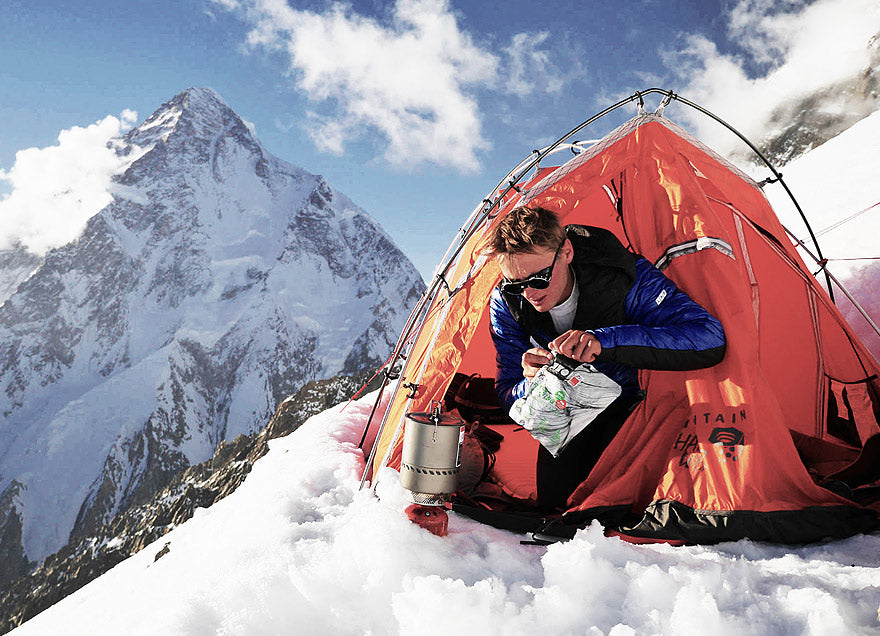
Andrzej Bargiel in Himalaya
"Storm" snacks are an important element of maintaining a constant level of energy during climbing or trekking. By not allowing our energy stores to deplete, we can support our physical efficiency as well as general well-being. There is no time to cook during the day, even to boil the water and therefore, you should take all kinds of energy snacks with you. Depending on the intensity of the effort as well as our individual preferences, we can use bars, gels, cookies, dried meat, crackers, sesame snaps, jellies, chocolate etc. Products that are not always considered "dietetic" in the lowlands can be the last resort in the mountains. It is worth taking care of variety and that is because after several days some products are no longer tasty due to monotony.
Pay attention if the products you are going to use are susceptible to freezing (there are bars on the market that do not freeze at -40°C) or if you can open them easily with gloves on, or if their consistency will allow you to chew during the effort. When leaving in the morning, prepare snack for the entire day. It is all about the easiest access. It is efficiency that counts in the mountains and there is often no time for frequent stops and making lunch on the trail or in the wall. Hence, placing various sweets in your pockets, flap of the backpack or in the pocket of the backpack hip belt guarantees constant access to energy while moving. By placing small snacks in each pocket you are likely to grab something to eat ''by chance'' while reaching for a head torch and this will allow us to follow nutrition recommendation more consistently.
How to estimate the amount of food we need?

Ines Papert and Mayan Smith-Gobat
Most of all, we need to plan the amount of ''mountain days''. The trip itself is often longer due to the logistics, i.e. reaching the mountains. It is worth focusing on planning the nutrition for the maximum number of days we plan to spend outside of civilisation. For example, when planning 15 days of mountain action we can determine the number of meals we need for the entire trip. This amount we then multiply by the number of people taking part in the expedition. I suggest securing yourself with a small surplus in the event of unexpected or prolonged accommodation in the mountains.
When buying freeze-dried meals it is worth paying attention to the portion size. Is it "single/double" or maybe "small/large"? This significant difference in nomenclature determines whether a larger meal will be enough for two people or only one but very hungry. When choosing specific dishes, it is not always the best idea to choose only a few favourite ones. The taste often changes during mountain trips. Some products start to get boring, it is worth having an alternative.
What rules should be followed when composing your diet for high altitude trips?
Energy and nutrition. The energy expenditure, i.e. the amount of calories we need to take to be able to function properly increases in the mountains. This is not only because of the additional effort we put into climbing or trekking but the specificity of high-altitude metabolism. Staying at an altitude above 3000m above sea level increases our basic metabolism which is the amount of calories that our body needs to preserve its vital functions. It can use up to 25% more energy for basic processes than at sea level. To assess your basic needs (PPM) it is good to use one of the available formulas that take into account basic parameters such as: age, sex, weight and height. If we want to precisely determine the expenditure associated with the effort, we can use a sports watch with pulse measurement, or we can use the indicative values from the tables:
Energy cost of mountain climbing = 1.5 kcal per one kg of body weight per 10 minutes, which at a weight of 70kg gives more or less a value of 630 kcal per 1 hour of effort. If the upward approach is not too steep, it can be halved. For example, a 6-hour approach may involve an additional expense of 1500-3500 kcal, which in general, can total from 3000 to even 7000kcal. These values will change along with the prevailing conditions (temperature, wind, air humidity). Keep this in mind when implementing your nutrition and assessing whether you supplement the caloric demand sufficiently. Developing deficits can accumulate during the most important day = peak attack and reduce the chances of reaching it.
Sample calorific values of selected products:
Chicken Tikka Masala LYOFOOD - large portion 128g (500g after hydration) = 754 kcal
Soup of Tomato and Pepper cream LYOFOOD- 1 portion 37g (370g after hydration) = 139 kcal.
Red smoothie - strengthening fruit shake LYOFOOD - a mix of 42 g per 1 bottle (500ml) = 141 kcal
Standard carbohydrate gel ~ 30-45g = around 100 kcal
Energy bar ~ 40-70g = 150-280 kcal
The high altitude diet will be poor in some vitamins and microelements if it is not well thought out and this is due to the conditions and lack of access to fresh products. Especially in a case of physical effort, the demand for B vitamins, antioxidants, micronutrients such as magnesium, sodium, potassium and iron increases. How to supplement this demand? Do we need to reach for multivitamin formulations? Unfortunately, the majority of such products that are on the market perfectly fit in the saying "if something works for everything, it works for nothing". Before planning our supplementation in the mountains, it is worth to go for basic blood tests before the expedition and then, after proper analysis, focus on selected supplements, which will be tailored to both us and the nature of the trip. A safe and best available option in the context of supplying vitamins and microelements at high altitudes are soups, fruits and freeze-dried cocktails. They are light, although low in calories, but they give us something as important as calories: a number of vitamins needed for blood formation processes (the effect of acclimatization) and they will support our regeneration and well-being every day. Unfortunately, the deficiencies accumulate and often we feel the most negative effects at the end of our trip, that is, around the most important day: the peak attack.
Sample compositions of selected LYOFOOD cocktails:
Red organic vitamin drink from fruits and vegetables: strawberry 53%, blackcurrant 35%, beetroot 12%
Green smoothie - cleansing shake from fruits and vegetables: apple 35%, kiwi 35%, pineapple 21%, spinach 4%, nettle 4%, ginger
The content of selected vitamins:
Organic freeze-dried blackcurrant -> 1 teaspoon replenishes ~ 90% of the recommended daily intake of vitamin C
Organic freeze-dried kale -> 1 teaspoon replenishes ~ 394% of the recommended daily intake of vitamin K
Read ingredients
Did you know that eliminating unnecessary food additives: dyes, emulsifiers, preservatives, flavor enhancers is, apart from health aspects, particularly important at high altitude conditions? Due to the lower availability of oxygen along with increasing altitude, our digestive system functions worse, the mucous membrane becomes delicate and it becomes much easier to suffer from indigestion or discomfort. Physical effort deepens this effect. Ingredients that are added to processed foods to improve taste and consistency may result in the retention of food content which will then affect the perceived well-being and gastro-intestinal problems. Before you reach for the popular "instant soups", think about whether it would be better to use a nutritious pepper and tomato cream. It is worth taking care of the quality of nutrition in the mountains.
Hydration

Colin Haley in Himalaya. Photo Guillaume Vallot
The most important aspect of nutrition at high altitudes. At high altitudes, our demand for liquids increases several times, it is related to, among others, physiological changes in our body (acclimatisation process). It can range from 4 to even 6 litres and more per day. This is the basic prevention of altitude sickness.
How to supplement this demand? It is worth dividing the hydration process during the day into 3 stages:
- morning hydration: after waking up and for breakfast. About 0.5-1l.
- hydration during mountaineering (depending on the method of movement and our individual preferences: water bottle, bottle, flask, thermos). About 1.5-3l
- replenishing losses from the entire day after reaching the base or tent. Here we care for proper hydration after our effort ends. About 1.5-2l.
When planning hydration for particular seasons, we will avoid accumulating deficits which will later be hard to replenish at once.
Of course, these are approximate values and depend on many factors such as: individual demand, intensity of sweating, intensity of effort, ambient temperature, etc. However, it is worth realising that they are much larger than at sea level. During intense climbs or trekking, water alone is not enough. It is worth taking advantage of additional supplementation in the form of tablets or a water-soluble carbohydrate-electrolyte powder. Especially when the water we drink comes from melted snow, which is barren and can even work contrary to what we want, increasing dehydration.
Individual preferences
Following golden rules given to us by our dietitian is nothing if we do not take care of the MOST IMPORTANT thing in the mountains: our appetite and taste. At an altitude above 3000m above sea level, our body can experience the so-called "high altitude anorexia", which is manifested by a reduced appetite, achieving satiety after eating smaller portions and a decrease in body weight. How to prevent this? Do not forget about snacks during the day, high-quality products and do not overuse hard-to-eat dishes. It is worth having our favourite and tested products with us. However, we try to ensure that one flavor does not dominate, because there is a risk that it will get boring quickly. It is worth taking care of both our needs and taste buds. A compromise is what best defines a high-altitude diet.
Eating in the mountains should be tasty, filling and easy to make. At the moment, we have so many healthy options on the market that it is worth looking for the ones that are most valuable and best suited to our needs among ready-made solutions. All this to make the way to the top not so much as easy, but it gives us uninterrupted experience of the best possible quality.

Marta Naczyk - sports nutritionist in the project „Forma na Szczyt”. She practices mountain runs, climbs and combines these sports into one common passion - a sports dietetics with mountain experience in the background. Lecturer at the Medical University of Gdansk, Marta deals with nutrition of people who are preparing for high altitude expeditions, climbs and do endurance sports (ultra runs, cycling, triathlon). She translates nutritional recommendations supporting performance and acclimatization processes into individually created nutritional logistics of high altitude expeditions. Nutritionist and trainer of the National Winter Expedition on K2 2017/2018.
All images and text: © LYOFOOD press materials
Leave a comment
Comments will be approved before showing up.


